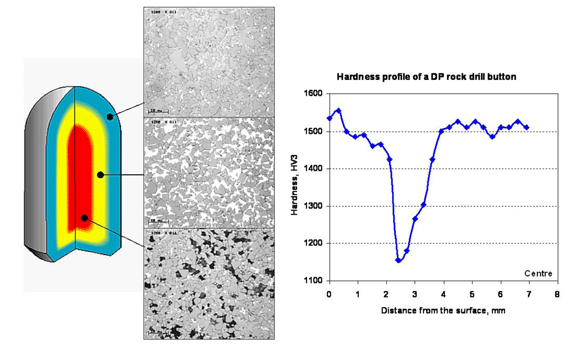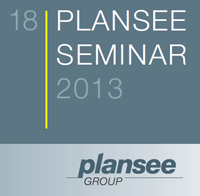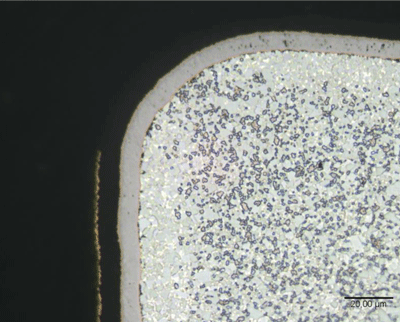Plansee Seminar 2013: Global R&D trends in the PM hardmetals industry – Part two
To view part one of this article click here
REACH and alternative binders
REACH, so far, has classified cobalt as very toxic for human health [2]. Also, the US National Toxicology Program, NTP [3], states that the tungsten carbide-cobalt hardmetal dust has been shown to be more toxic in combination than either pure cobalt or tungsten carbide by alone.
There has been a flurry of activity to find alternatives to the cobalt binder in hardmetals, not only since the spectre of REACH has become reality. The potential health risk of inhalation of hardmetal raw powders and dust in the cemented carbide industry production lines has been studied by different organisations and the results could be a cause for concern. The alternative to cobalt as a binder is either iron based or nickel based. From the health and safety aspect, nickel based alloys do not offer any advantages, though they do exhibit a good combination of properties, if tailored to the application.
A vast body of past and current literature on the pros and cons of using iron as an alternative binder exists and shows that replacing cobalt by application tailored iron based grades is possible, but that also more research work on alloy design and quality control issues are necessary.
Gradients
Gradient cemented carbides allow tailoring important properties such as stiffness and toughness in a single hardmetal component in different areas such as skin and core. Established gradients in the cemented carbide industry are the so-called γ-phase-free gradients for metal cutting applications and macro-gradients for rock tools applications . However R&D publications on development of γ-phase-free gradients in cemented carbides have become fewer over the last decade. A reasonable explanation is the increased focus on the development of novel CVD and PVD coatings for machining applications, especially relating to coating composition, nanostructure, adjustment of texture, residual stress, post treatment processes and bonding between layers and layer to substrates and more.
Current research mainly focuses on the production, characterisation and modelling of either γ-phase-free gradients, produced by denitridation of TiN-containing cemented carbides in vacuum atmospheres, or γ-phase-rich surface layers produced by nitridation of cubic carbide containing cemented carbides.
Special interest has been devoted to the effect of alternative binders (Fe-Ni-Co compositions) on the formation of gradients and their properties using nitrogen not only in the WC-TiC_TaC system but also in the Ti-Zr carbonitride system. Iron in the binder is beneficial for the formation of gradients, due to the higher activity of nitrogen in iron. The effect is highly dependent on composition and process conditions.
Computational thermodynamics has been successfully applied to model the kinetics of gradient formation in both Co-based cemented carbides. Good agreement between experiment and simulation regarding layer thickness, phase fraction distribution and element profiles was obtained on DICTRA modelling of gradient formation kinetics considering that all diffusion occurred in the liquid binder phase of a dispersed system model for example in Ni-based cemented carbides.
Nitridation of cemented carbides and cermets has once again been resurrected by various research schools in order to generate gradients that show superior wear properties in metal machining.

Fig. 3 The three distinct zones of the DP- carbide (Courtesy of T Hartzell, Sandvik Mining Rock Tools)
Macro gradients
In the field of macro gradients, the Dual Property (DP) hardmetals for mining applications are one of the most well known cemented carbides since 1988 using macro-gradients. Controlled redistribution of the cobalt binder phase gives components which contain three distinct microstructural zones. These gradients, together with their differences in thermal expansion, redistribute the internal stresses. It is, for example, possible to create a very hard and wear-resistant surface layer which is simultaneously pre-loaded with compressive stresses to prevent the initiation and propagation of cracks. Carbide having such a distribution of properties has high wear resistance at the surface combined with a tough underlying region. The initial application area was in rock drilling but today macro gradients are also used for tube and wire drawing tools and cold heading dies.
Modelling in manufacturing process and product application
Modelling has become a powerful tool in engineering and the hardmetal industry is no exception. Modelling of carbide production processes and applications are prevalent in the industry with reasonable success. But it is a challenge to develop suitable models to describe the behaviour of hardmetal since it is a composite consisting of metallic binder and hard refractory metal phases.
Modelling of pressing and sintering
Continuing development of modelling methods is needed to simulate hardmetal pressing and sintering processes. One recent attempt is multi-scaled or hierarchical model, which tries to integrate different dimensional orders of scale together. Intrinsic properties resulting from pressing could be considered as input to the modelling of sintering, such as initial inhomogeneity of microstructure, distribution of WC and pores, and localised residual stress in ‘green body’. Other factors such as grain growth, phase change, heating cycle, should also ideally be included.
Modelling of product performance in applications
Modelling can shorten the new product development cycle, optimise parameters for field applications, and significantly reduce cost before going into mass production (Fig. 4).

Fig. 4 Examples of FEM simulations for Sandvik products (a) Stress distribution in a stainless steel wire drawn through a hardmetal die (b) Image of the calculated stress distribution within a press-fitted hardmetal tool
In the design of hardmetal anvils for diamond synthesis for example, FEM can effectively assess stress distribution under different pressure, as well as changing dimensions and shape of the designed carbide component. Engineers also utilise FEM to simulate chip formation in the machining process, residual stress in micro-milling, wear mechanisms and the influence of cutting heat on tool life and to understand the plastic deformation and fracture of hardmetal, also under fatigue conditions. The development of measurement and experimental techniques is very much concurrent with modelling improvement.
Outlook
In her closing remarks, Norgren stated, “A clear focus area for metal cutting and wear parts is fine grained hardmetals. In metal cutting, improved PVD techniques generating thin coatings on sharp cutting edges which benefit from fine grained cemented carbides, widens the application field for inserts and round tools. In solid endmills and drills, PVD coated fine grained cemented carbides are taking market share from traditional high speed steel cutting operations. With the increasing knowledge about interface structures, doping and properties this area will continue to grow.”
“Combined with the increased research activity in alternative sintering processes as, for example, field assisted sintering, spark plasma sintering and pulsed electric current sintering, the opportunity to go even finer in grain size on an industrial scale will be possible. Increased understanding of the physical phenomena governing WC grain growth and interfacial properties gained from combined atomistic and thermodynamic modelling together with microscopy studies will almost certainly result in further development of fine grain cemented carbides.”
“In the future we will see an increased use of 3D techniques; for example the 3D atom probe and reconstructions of real 3D structures by combining Field Ion Beam (FIB) and EBSD techniques,” Norgren added.
“High R&D activity in the field of alternative binders will continue. Fe-based alternative binders are used in some applications such as woodworking and special wear parts, more effort in alloy design, production and quality control is required to attain universality of application and production friendliness in a highly competitive market. Nevertheless, alternative binders are a future trend and will be even more important due to the new health legislations for Cobalt.”
Norgren stated that “Modelling of manufacturing processes and product applications, will play an even more important role in carbide industry. It will cover a wide range of applications, from materials grade development, process optimisation, design automation, to product application and performance. Concluding the work being reviewed here, the future trends are: 1) Moving towards hierarchical modelling or multi-scales modelling at different scale, micro, meso, and macro, 2) Full product modelling from product design to processing and application, 3) Model validation, including materials characterization and measurement, and 4) Product performance monitoring.”
References
[1] ITIA/Report/Tungsten Statistical Report – September (2012)
[2] http://ec.europa.eu/environment/chemicals/reach/reach_intro.htm
[3] http://ntp-server.niehs.nih.gov/
Acknowledgements
This review was prepared from the Proceedings of the 18th Plansee Seminar, Reutte, June 2013.
News | Articles | Market reviews | Search directory | Subscribe to e-newsletter







